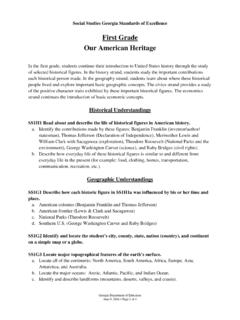Transcription of Science Georgia Standards of Excellence Seventh Grade ...
1 Science Georgia Standards of Excellence Seventh Grade Standards The Science Georgia Standards of Excellence are designed to provide foundational knowledge and skills for all students to develop proficiency in Science . The Project 2061's Benchmarks for Science Literacy and the follow up work, A Framework for K-12 Science Education were used as the core of the Standards to determine appropriate content and process skills for students. The Science Georgia Standards of Excellence focus on a limited number of core disciplinary ideas and crosscutting concepts which build from Kindergarten to high school.
2 The Standards are written with the core knowledge to be mastered integrated with the Science and engineering practices needed to engage in scientific inquiry and engineering design. Crosscutting concepts are used to make connections across different Science disciplines. The Science Georgia Standards of Excellence drive instruction. Hands-on, student-centered, and inquiry-based approaches should be the emphasis of instruction. The Standards are a required minimum set of expectations that show proficiency in Science . However, instruction can extend beyond these minimum expectations to meet student needs.
3 At the same time, these Standards set a maximum expectation on what will be assessed by the Georgia Milestones Assessment System. Science consists of a way of thinking and investigating, as well a growing body of knowledge about the natural world. To become literate in Science , students need to possess sufficient understanding of fundamental Science content knowledge, the ability to engage in the Science and engineering practices, and to use scientific and technological information correctly. Technology should be infused into the curriculum and the safety of the student should always be foremost in instruction.
4 The Seventh Grade Georgia Standards of Excellence for Science are designed to give all students the necessary skills for a smooth transition from elementary life Science Standards to high school biology Standards . The purpose is to give all students an overview of common strands in life Science including, but not limited to, diversity of living organisms, structure and function of cells, heredity, ecosystems, and biological evolution. Seventh Grade students keep records of their observations, use those records to analyze the data they collect, recognize patterns in the data, use simple charts and graphs to represent the relationships they see, and find more than one way to interpret their findings.
5 They make and use observations to explain the diversity of living organisms and how the organisms are classified, how they reproduce and how genetic information is passed from parents to their offspring. They use different models to represent systems such as cells, tissues, and organs. They use what they know about ecosystems to explain how matter cycles and energy flows through the ecosystem. They use the concepts of natural selection and fossil evidence to construct explanations about the diversity of life that they see. Seventh graders plan and carry out investigations, describe observations, and show information in graphical form.
6 The students replicate investigations and compare results to find similarities and differences. Georgia Department of Education March 31, 2016 Page 1 of 4. Science Georgia Standards of Excellence Life Science S7L1. Obtain, evaluate, and communicate information to investigate the diversity of living organisms and how they can be compared scientifically. a. Develop and defend a model that categorizes organisms based on common characteristics . b. Evaluate historical models of how organisms were classified based on physical characteristics and how that led to the six kingdom system (currently archaea, bacteria, protists, fungi, plants, and animals).
7 (Clarification statement: This includes common examples and characteristics such as, but not limited to, prokaryotic, eukaryotic, unicellular, multicellular, asexual reproduction, sexual reproduction, autotroph, heterotroph, and unique cell structures. Modern classification will be addressed in high school.). S7L2. Obtain, evaluate, and communicate information to describe how cell structures, cells, tissues, organs, and organ systems interact to maintain the basic needs of organisms. a. Develop a model and construct an explanation of how cell structures (specifically the nucleus, cytoplasm, cell membrane, cell wall, chloroplasts, lysosome, and mitochondria).
8 Contribute to the function of the cell as a system in obtaining nutrients in order to grow, reproduce, make needed materials, and process waste. (Clarification statement: The intent is for students to demonstrate how the component structures of the cell interact and work together to allow the cell as a whole to carry out various processes. Additional structures, beyond those listed, will be addressed in high school Biology.). b. Develop and use a conceptual model of how cells are organized into tissues, tissues into organs, organs into systems, and systems into organisms.
9 C. Construct an argument that systems of the body (Cardiovascular, Excretory, Digestive, Respiratory, Muscular, Nervous, and Immune) interact with one another to carry out life processes. (Clarification statement: The emphasis is not on learning individual structures and functions associated with each system, but on how systems interact to support life processes.). S7L3. Obtain, evaluate, and communicate information to explain how organisms reproduce either sexually or asexually and transfer genetic information to determine the traits of their offspring. a.
10 Construct an explanation supported with scientific evidence of the role of genes and chromosomes in the process of inheriting a specific trait. Georgia Department of Education March 31, 2016 Page 2 of 4. Science Georgia Standards of Excellence b. Develop and use a model to describe how asexual reproduction can result in offspring with identical genetic information while sexual reproduction results in genetic variation. (Clarification statement: Models could include, but are not limited to, the use of monohybrid Punnett squares to demonstrate the heritability of genes and the resulting genetic variation, identification of heterozygous and homozygous, and comparison of genotype vs.)










